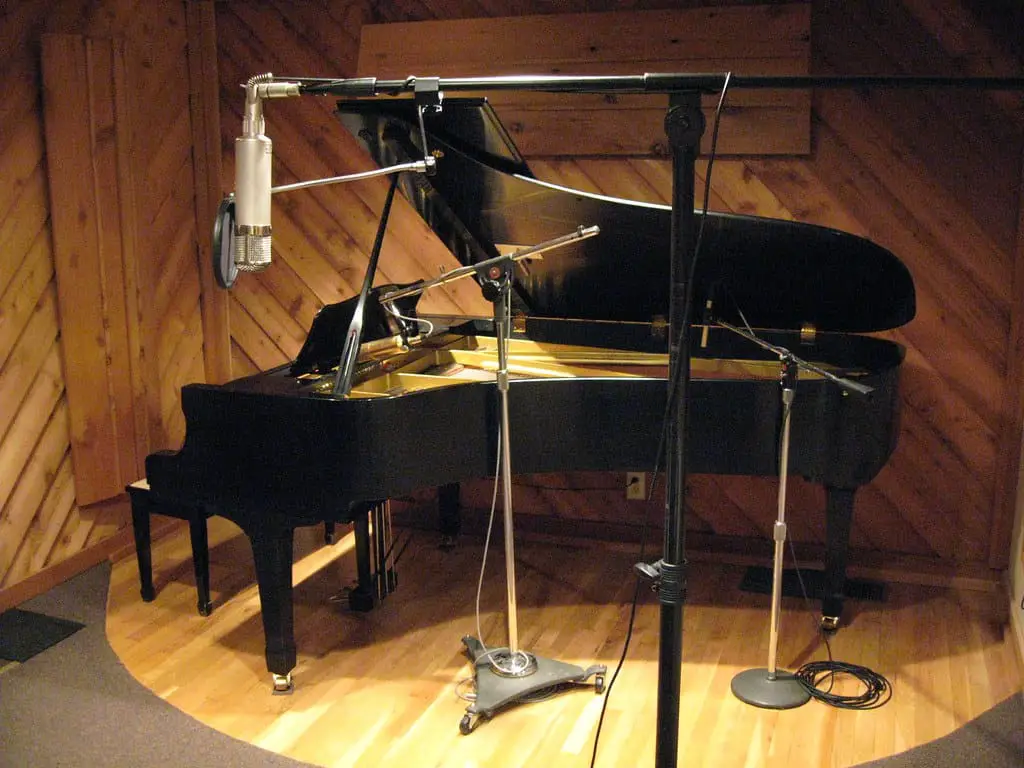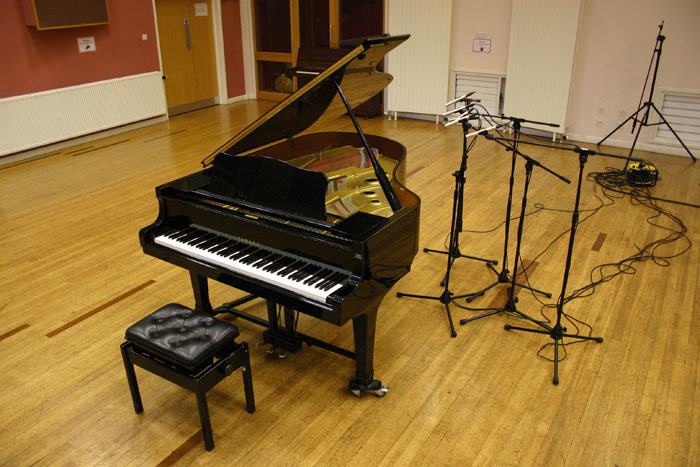Are you looking for the best way to record piano sounds? You’ve come to the right place!
This guide will show you tips and tricks to get the best sound from your piano mic. Discover how to capture crystal clear notes and how to adjust your microphone techniques for optimal results.
The piano is one of the most versatile and beautiful instruments. Its sound can be as delicate or powerful as the pianist desires. To capture and amplify this sound, a mic is needed. But how do you choose and use the best mic for your piano? This guide provides tips and tricks on how to select, setup, and use microphones for recording or amplifying acoustic pianos in both studio and live situations.
We will start by discussing the different types of mics available on the market, then move onto placement options, common settings to consider, other accessories you may need for the recording session or live performance, using effects (if necessary), monitoring techniques, signal processing and much more. By the end of this guide you’ll be ready to record or amplify your piano with confidence!
Importance of achieving the best sound quality when recording a piano
Achieving the best sound quality when recording a piano is critical, as it allows you to capture the instrument’s natural tones. A good-sounding recording will represent the piano accurately and bring out the subtle nuances of its acoustic character. Quality recordings can be used in any form of music production, such as in a traditional classical setting or when creating pop music.
When mic’ing up a piano for recording, there are several challenges that come into play. This includes selecting the right microphone (or combination of microphones) and positioning them correctly. Additionally, every room has its own acoustic characteristics; hence, soundproofing and other treatments should be taken into account when setting up your recording environment.
Before getting started with mic’ing up the piano, it is important to consider how much separation you want between individual notes and chords. Additionally, if specific articulations from the strings or hammers need to be highlighted or reduced in volume, this must also be addressed prior to starting any mic placement or adjustment. Mic placement is key for getting a good balance between each note/chord so that its nuances are accurately captured without sounds from other registers being blended together—thereby resulting in an over-ambient soundscape rather than natural orchestration/harmonic structures being conveyed.
Finally, remember that every detail matters when aiming for a great sounding recording; hence take time to experiment until you find what works best for your individual setup and preferences!

Overview of the guide
This guide is aimed at helping you get the best sound from your piano mic in almost any situation. We will discuss mic choice, setup considerations, and some tips and tricks for micing a piano in a live or studio environment. Whether you are looking to capture a warm, soft tone or an intense, dynamic one — this guide will provide you with the information needed to achieve great results.
In addition to providing tips and tricks on mic selection and placement, we will provide some advice on how to obtain the most natural sound possible — such as regulating humidity levels in your recording space or choosing between direct versus ambient miking techniques.
At the end of this guide, we will also look at different techniques that can be used when mixing a mic-recorded piano performance — so you’ll be able to take your recordings from good to great! So let’s get started by discussing what kind of microphone is ideal for recording piano.
Factors to Consider When Choosing a Piano Mic
When choosing the right mic for a piano, there are a few factors to take into consideration. First, the pickup pattern of the mic—or whether it will record sound from a certain direction as opposed to every direction—is important; for example, mics with an omnidirectional pickup pattern pick up sound evenly from all directions, whereas mics with a cardioid pickup pattern only pick up sound from in front of them. Make sure your microphone is specifically designed for pianos so you can get the best possible sound quality.
The frequency response is another key factor to consider when selecting a mic for pianos as it entails how well and how accurately the microphone picks up various frequencies of sound. This can also heavily influence your envisioned sound quality—for instance, some mics offer vocal-focused frequency responses that emphasize nearby distinct vocal ranges while cutting back on bass frequencies; while others have grand piano-focused frequency responses tailored to long–ranged bass and treble notes that create expansive yet powerful sounds. Selecting which type you would prefer should be done according to what kind of music or instrumentation you plan to use your created sounds on later.
In addition, keep in mind that not all mics are loud enough to capture every part of background noise you may want included in your piano recording; a higher sensitivity will provide more detail and clarity than one with lower sensitivity. Higher bit rates and sample rates also improve audio fidelity, but these are more dependent on the type of recording equipment being used rather than solely being based on mic selection.
Sound Quality
Achieving a great sound when miking your acoustic piano is no easy task. Depending on the characteristics of the instrument you are recording, you will have to go through a number of steps in order to get the desired result. In this guide, we will provide you with tips and tricks for getting the best sound quality out of your acoustic piano mic.
The type and placement of your microphone are key factors in recording pianos. Small diaphragm condenser microphones allow for accurate pickup with minimal coloration, while large diaphragm condensers may give you more fullness and resonance. Experimentation is key – try multiple positioning options to hear what works best with your particular instrument. You should also pay attention to room acoustics, as different rooms may require different mic placements or dampening techniques (such as foam padding).
It’s also important to take into account the size and range of your instrument when selecting a microphone. For example, if you’re miking a baby grand piano or an upright, small diaphragm condensers are usually recommended – but if it’s an especially long grand piano (larger than seven feet), larger condenser mics may be better suited because they can capture more of the harmonic content from all ends of the keyboard.
In some cases, such as those requiring more distant miking techniques (recording from further back in the room), directional microphones can be used to produce unique dynamics — try out a cardioid or even an omni-directional microphone! There’s no one “right” way to mic up a piano — these are simply options worth exploring when attempting to capture that perfect sound from your acoustic instrument.
Sensitivity
The number one factor that affects the sound of a piano mic is its sensitivity, or the measure of how much energy (sound) it needs to create an electrical signal. Often expressed in terms of decibels, higher sensitivity produces more natural, dynamic sounds when collecting audio from a piano. When selecting a mic for your piano recordings, look for one with good sensitivity for accurate and realistic reproduction of the instrument’s unique tonal qualities.
Additionally, consider size and distance when it comes to recording a piano. Take into account the space you have available to determine what type of microphone will work best. Some larger microphones require stand mounting while others are more adaptable and can fit into tight spaces without sacrificing sound quality in any way. Lastly, proximity plays an important role in capturing the best possible sound – closer is usually better when it comes to miking up acoustic instruments like pianos as they are highly sensitive and need accurate replication without losing fidelity and clarity.

Polar Pattern
The polar pattern of a microphone is a very important aspect to consider when setting up a mic for recording drum sets, electric guitars, grand and upright pianos. The polar pattern is the three-dimensional space around the capsule in which the mic will pick up sound. That space can vary depending on the type of microphone chosen and how its patterns are used.
A cardioid (heart-shaped) polar pattern is generally regarded as the most suitable type of polar pattern to use with pianos, since it helps to increase isolation and cut down on background noise. This implies that only sound originating directly in front of the capsule will be picked up by this type of mic, minimizing unwanted noise that would otherwise be recorded from other parts of the room. Other common polar pattern types include: supercardioid, omnidirectional, bidirectional (figure-8), and wide cardioid patterns.
It’s also important to note that certain microphones may have adjustable polar patterns, allowing you to easily switch between different patterns for more versatile audio capture options. Investing in a good quality piano mic with an adjustable polarization option is a great way to ensure excellent sound quality regardless of what instrument you are trying to record or what room acoustics you are working with at any given time.
Frequency Response
The frequency response of a microphone plays an integral role in determining the overall sound of the recorded piano. Choosing a microphone with the right frequency range for your recording application can make a great difference. A flat or well-balanced frequency response will ensure that all the notes of the instrument are captured without any distortions or loss of clarity.
Most modern mics usually come with a wide frequency range, which makes them suitable for recording instruments like piano. In general, you should look for microphones that can accurately capture frequencies between 50Hz and 16kHz — this range is perfect for capturing a piano’s full sound spectrum. Some mics may even go up to 20kHz and beyond, but this should be more than enough to pick up all the nuances of a standard acoustic grand piano.
When microphone shopping, pay close attention to specs such as type of transducer used (condenser or dynamic) and noise floor rating — these characteristics directly shape the sound quality and overall performance of your mic. Testing different models before purchase is highly recommended to find one that works best for your specific needs and budget.
Budget
If you’re on a budget, there are still some effective ways to get the best possible sound out of a piano mic. Here are some tips:
- Choose the right mic for your situation. While condenser mics often provide better sound quality for recordings, dynamic mics work better in live situations. Make sure to consider both types when searching for the right mic for your recording project or performance.
- Pick a good location for the mic. A good rule of thumb is to place it at least 4 feet (1.2 meters) away from your instrument’s soundboard, as this will diminish any room noise or reverberations that may affect the 2nd microphone when set up in a stereo pair system.
- Test different polar patterns and levels of sensitivity until you get something that works with what you need it to do; this is where experimentation comes into play—try slight variations and see what works best for each situation.
- Consider other factors such as audio compression and equalization tasks to get the most out of your recording sessions; often, devices such as compressors can help refine and enhance your recordings by adding extra clarity and low-level detail to them when used appropriately.

Conclusion
Finding the perfect microphone for creating studio-level recordings of your electric piano, organ or acoustic piano can be a challenging task. However, with the right techniques and equipment, you can create professional-sounding recordings without emptying your wallet. Although there is no magic formula when it comes to producing the perfect recording of your piano, paying attention to all aspects of sound becomes easier when you focus on a few simple points.
First and foremost, keep in mind that no matter how good the mic is, without proper placement it will not produce desirable results. In addition to strategic positioning within the room, be sure to take into account other factors such as microphone choice and amplification to ensure you get an accurate representation of what’s coming from your instrument. With patience and diligence you can build an audio recording setup that captures high-quality sound from both electric pianos and acoustic grand pianos.
FAQ’S
What is the best way to mic a piano?
The best way to mic a piano is to use a pair of condenser microphones placed above the strings inside the piano.
How can I make my piano sound better when recording?
To make your piano sound better when recording, you can try adjusting the mic placement, using high-quality microphones, treating the recording room for acoustics, and applying EQ and other post-processing techniques.
What is the 3 to 1 rule piano?
The 3 to 1 rule for piano refers to the practice of placing the microphones at a distance from the piano that is three times the distance between the microphones themselves.
How do you use a piano mic?
To use a piano mic, position the microphones inside the piano, close to the strings, and adjust the placement to achieve the desired sound.
How can I improve my mic quality for music?
You can improve your mic quality for music by investing in high-quality microphones, using proper mic placement and technique, and utilizing EQ and other post-processing tools.
What makes a piano sound good?
Several factors contribute to a piano sounding good, including proper tuning, good quality hammers and strings, proper maintenance, and proper mic placement and recording techniques.
How can I practice piano quietly?
You can practice piano quietly by using a digital piano with headphones, or by placing a mute or practice pedal on an acoustic piano.
Should I record piano in mono or stereo?
Recording piano in stereo can capture a more immersive and realistic sound, but recording in mono can be useful for certain styles of music or for simplifying the mixing process.
How to do vibrato on piano?
To create vibrato on piano, gently and quickly shake your wrist while holding down the key, or use the sustain pedal to create a natural, subtle vibrato.
Why are condenser mics good for piano?
Condenser microphones are good for piano because they are sensitive and can capture the nuances of the piano’s sound, including the subtle harmonics and overtones.
See Also:
- Best piano mic 2023
- Best portable digital piano 2023
- Best portable piano keyboards 2023
- Best upright piano 2023
- Best yamaha digital piano 2023


